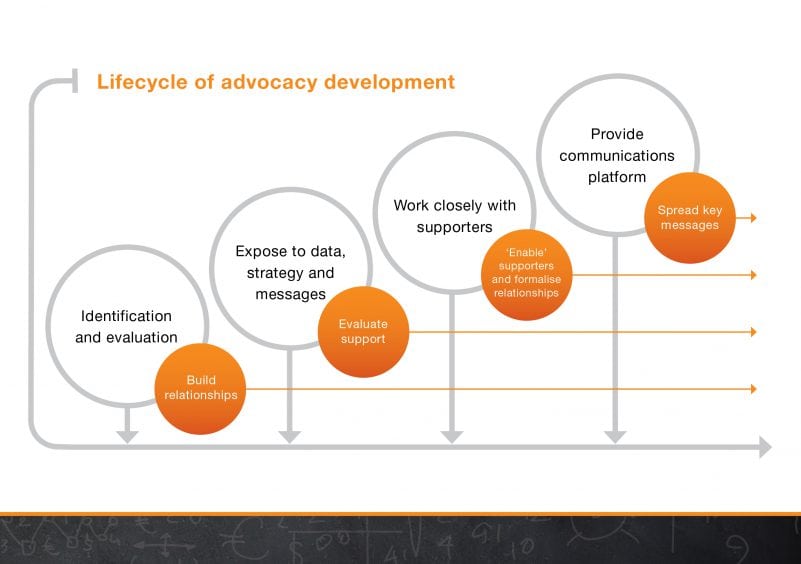Good data is nothing without advocacy
June 26, 2019 |
In a world focused on improving outcomes, the days when drugs sold themselves on data alone have long gone. While the need for good data is indisputable, it is now important for us to be able to take this data and clearly communicate what it really means.
Additionally, the healthcare market is becoming an increasingly ‘noisy’ environment, restricted by tighter budgets and more stringent compliance codes, with drug developments often being only incremental. Therefore, how data is communicated and by whom is important to influence the target audience.
As such, for most pharma companies, advocacy development has to be the most important strategic imperatives for sustaining and leveraging successful product life cycles, from launch to maturity.
What is effective advocacy in the pharmaceutical sector and what can it do for you?
Having a network of recognised industry experts (usually doctors), who act as spokespeople for a product or brand, has long been key to increasing brand awareness and ultimately brand acceptance among healthcare professionals (HCPs). These respected key opinion leaders (KOLs) have a strong voice and can provide invaluable advice to HCPs at meetings and congresses, including giving feedback via advisory boards. They are crucial in gaining traction with doctors and pharmacies for your brand.
Additionally, changes in the way that people access information today mean that advocates can act as influencers on social media, whether focused on HCPs or patient groups. Peer opinions and support are often highly regarded and sought after, and online media has the potential for highly targeted messages with a potentially infinite reach. Consequently, advocates with a strong social media presence are becoming increasingly important in the advocacy mix.
Advocacy is particularly beneficial at the launch stage of a product life cycle, as it can provide favourable independent voices when it comes to funding decisions and can be seen as ‘investing in intelligence’, therefore facilitating market access for your product.
Building a successful advocacy development programme
First, consider what good advocacy looks like and use these parameters to build an advocacy development plan:
- Recognition and relationships:
- Brand/company recognition
- Overall opinion and impression of your brand/company
- Quality and quantity of relationships within the therapy area
Willingness to engage
- Agreement to participate in programme activities
- Provision of useful feedback in meetings
- Help with study enrolment / publications / congresses, etc.
- Sales and market research
- Recommendation of peers
Mix of advocates:
- Advocates who are keen to engage and educate their peers
- Credible and trustworthy advocates to promote and align your brand with overall strategy
- Variety within the cohort to ensure broader reach and greater longevity of relationships
Second, consider your brand and company focus now, and in the future:
What is your current brand situation?
Who are your core consumers and how do you want them to perceive your brand?
What barriers are there to increasing the market share of your brand?
Third, build the advocacy development programme: define your objective, apply a robust strategy and plan carefully.
Possible options:
- Award panels
- Rising star academies
- CME
- Debating societies
- Educational faculties
- Policy steering committees
Also consider making a strategic and tactical plan for each advocate, mapped out with an advocacy matrix grid.
Choose wisely: Advocate selection and recruitment
Selection
Advocates must be highly knowledgeable and keen to share information with their peers; ideally, they should be influential, good communicators and viewed positively. KOL mapping exercises are vital at an early stage, and potential advocates should be open to forming long-term relationships.
Recruitment
Consider what motivation a potential advocate has for being involved – what’s in it for them?
Can you have a true symbiotic relationship?
Does your contracting process ensure transparency and compliance with relevant codes of practice?
Plan ahead: Long-term development
Managing roles
Ensure that no single advocate is overused or forgotten. Outline a specific series of activities within your programme to ensure that advocates are aware of their expected participation, and align advocates by their interests and abilities.
Developing charters
Charters can be used to define the roles and responsibilities of each advocate as well as the limitations on the terms and length of service. It also provides an exit strategy, as participants know the proposed longevity of their involvement with the programme, which increases trust and transparency.

Plan in the development stage: Avoid common pitfalls
Common pitfalls:
- Lack of time
- Lack of resources
- Lack of exit strategy
- No markers of success established
- Poor selection of advocates
- Poor recruitment of advocates
- Poor internal support/adoption
- Lack of the “what’s in it for me?” factor
Measurement
At the outset of any new programme, a set of key performance indicators (KPIs) should be developed to evaluate the value for money of the endeavour. This could range from fairly simple in scope, e.g. number and quality of publications, to complex, e.g. the impact on social media.
These KPIs will allow you to measure the impact of a given educational intervention and assess whether it has achieved its original objectives. At Porterhouse Medical, we have developed evidence‑based tools designed to measure the impact of advocacy programmes and educational interventions. Such tools capture data from participants in an accessible format and provide outputs that highlight the strategies that are working effectively.
Getting it right
If you get it right, effective advocacy and campaigns will give your data credibility and increase its reach, make your brand stand out from the crowd, and influence change. However, this doesn’t have to be tackled alone – med comms agencies have an important role to play in helping pharma companies achieve the best outcomes for your brand. Experienced agencies have the capabilities and resources to gain access to the KOLs who can help boost your brand. Such agencies can also ensure that no single advocate is overused or forgotten; define and communicate the expected participation levels; foster trust and loyalty; and help align advocates by interests and abilities. In addition, they can provide you with the insight, information and reach needed to expand the possibilities around your brand and increase profitability.
If you would any more information on advocacy development or our evidence-based tools to measure the impact of your advocacy programmes, please get in touch: http://www.porterhousemedical.com/contact
This content was provided by Porterhouse Medical Group





